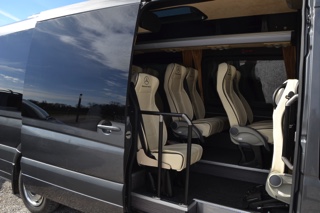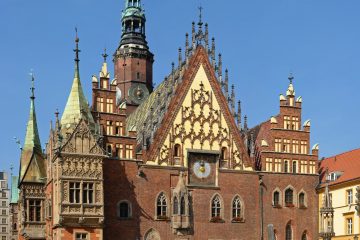Day 1

Day 1 – ARRIVAL IN WARSAW
On arrival at Frederic Chopin Airport, You will be met in the airport arrival hall & transferred to the Marriott Hotel.
Spend two nights there. Time to settle in relax and maybe take your first walk around Warsaw. Warsaw – the capital of Poland is beautifully located on the major Polish river – Vistula. The city was founded in the early 14th century and soon became one of the most important towns. In the course of time, it gradually gained political and social importance and King Zygmunt III Waza transferred the Royal official seat from Cracow in 1596. The reconstruction of Warsaw after World War II, which was raised to the ground during World War Two, became for Poles a matter of honor and was conducted with unprecedented determination. Up to today, Warsaw symbolizes the hard fight for survival. The Warsaw Mermaid on the coat of arms, holding her sword and raised shield, is the personification of this. Today Warsaw is the capital of the country known to have played a leading role in the breakdown of the Iron Curtain.
Day 2

Route: Warsaw
Meals: Breakfast, Lunch, Dinner
Hotel: Marriott Hotel Warsaw
After breakfast, You will explore Warsaw. Five hours Warsaw City Tour.
During this five-hour tour, You will see remnants of the former Jewish district together with the Ghetto Heroes Monument, the financial and commercial center, the tallest building in Poland and at the same time a socialist realism relic of the previous era – the Palace of Culture and Science. You will admire representative townhouses and former magnate residences on the Royal Route and have a walk across the Łazienki Royal Park – the summer residence of the last Polish king Stanislaw August Poniatowski, where we will see among other things the Palace on the Water and Amphitheatre with the scene on the water.
Itinerary:
- Old Town & New Town – the history of Phoenix, who rose from the ashes. Unique stories and legends. You will learn about what the Warsaw Mermaid and the one of Copenhagen have in common and explore the mystery of the unique crucifix from St. John’s Cathedral.
- Monument to Ghetto Heroes – You will learn the history of the prewar Jewish District
- New Warsaw – relics of the Polish People’s Republic- Palace of Culture &Science and a modern commercial and financial center.
- Łazienki Royal Park – a walk across the most charming of Warsaw’s parks, where You will explore: Palace on the Water-pearl of classicistic architecture in Europe, Theatre on the Island, Old Orangery and Myślewicki Palace.
Driving tour through Warsaw including Praga district and the panorama view of Warsaw from the
30th floor of the Palace of Culture and Science.
Light lunch at U Szwejka Restaurant. After lunchtime on your own.
Evening dinner at the local restaurant.
Day 3

Route: Warsaw- Auschwitz-Cracow
Meals: Breakfast, Lunch, Dinner
Hotels: Marriott Warsaw, Andel’s Hotel Cracow
Drive to Cracow after breakfast. On the way tour at Auschwitz-Birkenau former Concentration Camp. The concentration camp in Auschwitz was established by Nazis on the outskirts of the town Oswiecim in 1940. After the war, the camp was turned into a museum displaying evidence of the genocide. Block no. 11, known as the Death Block, was where people were murdered also at the “Wall of Death”. Outside the camp, there is a gas chamber, where 70, 000 people were killed in 1940-1943. In 1941, 3 kilometers from Oswiecim, in the former village of Brzezinka, the Nazis established a new camp called Auschwitz II Birkenau. In 1942-1945, approx. 1. 5 million people lived and died here. Most of them (90%) were Jews, others were Poles, Gypsies, Russians and prisoners from 28 countries of Europe, people of all nationalities and political and religious persuasions. Since 1944, transports of prisoners from all over the continent entered directly through the “Gate of Death”. In 1979, Auschwitz – Birkenau Concentration Camp was listed a UNESCO World Culture and National Heritage Site. Drive to Cracow. Check-in at Andel’s Hotel. Free time. Dinner at your own.
Day 4

Route: Cracow
Meals: Breakfast, Lunch, *Dinner (payment by the group)
Hotel: Andel’s Hotel
After breakfast departs for a half-day Cracow City Tour. Our tour starts in front of the main gate – St Florian’s Gate which leads us to the center of the city. The medieval defensive walls – Barbican are well preserved and they have remained up till now in their original form. Via Floriańska Street – a part of the Royal Route – we get to the Main Market Square which is the heart of the city. It used to be a commercial, administrative and religious center of Krakow, so that is why today we could admire the most important buildings – the Renaissance Cloth Hall, the medieval Tower of the Town Hall and the Gothic church of Saint Virgin Mary – the famous for the biggest medieval wooden altar sculptured by Wit Stwosz. On the way to Wawel Hill, we will pass through the University District which is one of the oldest universities in Europe founded in 1364 by king Casimir the Great. At last but not least, we reach Wawel Hill, one of the most important places in Krakow, where You explore Wawel Castle and the Cathedral-both were built at the very beginning of the existence of the Polish state – in the 10th century. Krakow’s Cathedral used to be a coronation and burial site for Polish kings from the 14th to 18th centuries and a national pantheon. The Wawel Royal Castle, rebuilt by Italian artists Niccolo Castiglione and Mateo the Italian in the 16th century, holds a unique collection of 16th-century Flemish tapestries.
Jewish prewar district – Kazimierz and Podgórze District Tour- Jewish population had played an important role in the Kraków regional economy since the end of the 13th century, granted the freedom of worship, trade and travel by Boleslaw Pious the duke of Greater Poland issued already in 1264. Kazimierz, as the town founded by king Casimirus the Great in the 14th century, was originally a Christian city. By the end of the fifteenth century Jews had been expelled. Before the Second World War Cracow was an influential center for the 60,000 Polish Jews. The Krakow Ghetto was formally established on 3 March 1941 in the Podgórze district, not in the Jewish district of Kazimierz. During that driving & walking tour, You will have a chance to see all seven of Kazimierz’s Synagogues, one of them active and connected with a Jewish Cemetery. Then the route will lead us to Podgorze District, the location surrounded by buildings that witnessed the Holocaust. You will explore the Schindler’s Factory and the remnants of the Ghetto’s wall from the World War II period.
Itinerary:
- Remuh Synagogue with the old Jewish cemetery
- Wolnica Square (old meat market)
- Progressive Synagogue (Tempel)
- New Square with former Ritual Slaughterhouse for poultry
- Sites from the Steven Spielberg’s Schindler’s List
- The building that used to be a Ritual Bath
- Former main ghetto square
- Remnants of the ghetto wall
Free evening.
Day 8
Route: Wrocław-Gdańsk (Danzig)
Meals: Breakfast, Lunch and Dinner on your own
Hotel: Hansa
After breakfast drive to Gdańsk. On the way to Gdańsk, we will stop in Gniezno which was the cradle of the Polish state in the early Middle Ages. In Gniezno You will explore:
The Basilica of the Assumption of the Blessed Virgin Mary
Old Market Square
Continue to drive to Gdańsk After arrival accommodation at your hotel Hansa Hotel.
Free evening.
Day 10

Route: Gdańsk- Malbork- Warsaw Meals: Breakfast, Lunch After breakfast we head towards Warsaw. On the way we will stop at the stunning Teutonic Knights Order Castle in Malbork.
You will explore the Castle with the internal museum guide – Duration 3 hours.
Drive to Warsaw-Lunch on the way to the capital of Poland. Time to say „GOODBYE” to Poland in Polish „DO WIDZENIA” Departure transfer to the airport for your flight back home.
| Tour dates | Double room rate | Single room rate |
|---|---|---|
| October – November | 2,620 Euro /per person + air | 2,700 Euro /per person + air |
| December – January | 2,620 Euro/per person+ air | 2,700 Euro /per person + air |
| January – February | 2,620 Euro /per person + air | 2,700 Euro /per person + air |
| February – March | 2,620 Euro /per person + air |
2,700 Euro /per person + air |
| March – April | 2,620 Euro /per person + air | 2,700 Euro /per person + air |
| April – May | 2,620 Euro /per person + air | 2,700 Euro /per person + air |
| May – September | 2800 Euro/per person + air | 2,900 Euro /per person + air |








